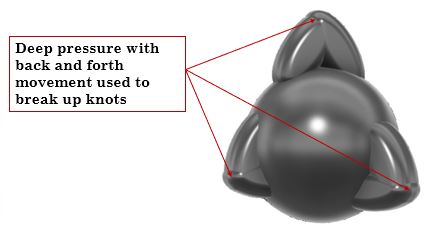
Cross Friction Massage / Transverse Friction Massage / cross-fiber massage typically uses two fingertips to apply deep pressure in a direction perpendicular to a tight muscle or line of scar tissue. It works to loosen the tight muscle and/or break down scar tissue. A session typically lasts for 5-10 minutes per area.
Performing a Cross Friction Massage may seem easy, but it is not. It requires a great deal of strength and stamina. The process can be aided tremendously by the addition of the right tool.
What makes a good Cross Friction Tool?
A cross friction tool needs to be easy to handle and allow a deep yet specific application of force. Using your fingers works well for a couple of minutes, but you will find that your fingers quickly start to hurt or fatigue.
If you’ve ever asked a friend or loved one to rub the knots out of your shoulders, you were probably disappointed by how quickly they tired of the chore. They and you would have benefited from a proper massage tool to help them get the job done. The Knuckleball™ is exactly that.

The edged tip of each knuckle allows for a very direct, yet precise, application of pressure. The differing heights allow for greater control over depth of penetration. The Knuckleball™ allows you to relax into the treatment rather than focusing on your aching fingers. See the Knuckleball™ being used for Cross Friction Massage below.
How Cross Friction Massage heals scar tissue?
Scar tissue is the newly formed tissue that forms after an injury, be it acute or chronic. It is generally thick and fibrous. In the early stages of healing, scar tissue might not be painful. But over time, it will start to tighten as it heals and become increasingly painful. It can interfere with mobility, contribute to headaches, and make you uncomfortable in general. That’s why helping scar tissue to heal properly is important.
Fortunately, releasing a scar can yield powerful results which can improve mobility, diminish complications and decrease the pain often associated with scar tissue. Working with scar tissue helps to stimulate remodeling, bringing the involved tissues back to a more normal pattern and configuration.

